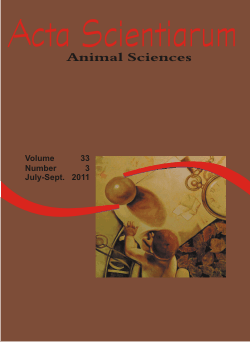<b>In vitro ruminal fermentation kinetics of Marandu grass at different harvest ages</b> - doi: 10.4025/actascianimsci.v33i3.9462
Keywords:
Brachiaria brizantha, degradation rate, gas production
Abstract
The objective of the work was to evaluate ruminal fermentation kinetics parameters of Brachiaria brizantha, harvested at 28, 35 and 54 days, using the semiautomatic in vitro gas production technique. Analyses were carried out for dry matter (DM), organic matter (OM), crude protein (CP), ether extract (EE), neutral detergent fiber corrected for ash and protein (NDFAP), acid detergent fiber (ADF), neutral detergent insoluble nitrogen (NDIN), acid detergent insoluble nitrogen (ADIN), lignin (LIG), total carbohydrates (TC), non-fiber carbohydrates (NFC), fraction B2 and the fraction C, respectively. The data of gas production were adjusted to the bicompartmental logistic model. The design used was completely randomized. The data were submitted to analysis of variance and regression, at the level of 5% probability. There was a significant effect (p <0.05), for the variables DM, NDFAP, ADF, NDIN, ADIN, TC, B2, with linear increase as harvest age advanced. For gas production, fraction A was similar between the ages of 28 and 35 days, with 95.75 and 116.8 mL g-1 of DM, respectively. The recommended age to obtain the best nutritional value of Brachiaria brizantha was 28 days.Downloads
Download data is not yet available.
Published
2011-03-21
How to Cite
Sá, J. F. de, Pedreira, M. dos S., Silva, F. F. da, Figueiredo, M. P. de, Rebouças, G. M. N., & Souza, D. R. de. (2011). <b>In vitro ruminal fermentation kinetics of Marandu grass at different harvest ages</b> - doi: 10.4025/actascianimsci.v33i3.9462. Acta Scientiarum. Animal Sciences, 33(3), 225-231. https://doi.org/10.4025/actascianimsci.v33i3.9462
Issue
Section
Pasture and forage utilization
DECLARATION OF ORIGINALITY AND COPYRIGHTS
- I Declare that current article is original and has not been submitted for publication, in part or in whole, to any other national or international journal.
The copyrights belong exclusively to the authors. Published content is licensed under Creative Commons Attribution 4.0 (CC BY 4.0) guidelines, which allows sharing (copy and distribution of the material in any medium or format) and adaptation (remix, transform, and build upon the material) for any purpose, even commercially, under the terms of attribution.
Read this link for further information on how to use CC BY 4.0 properly.
0.9
2019CiteScore
29th percentile
Powered by 








































